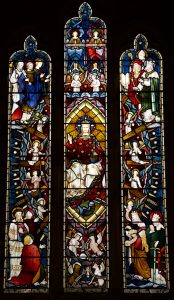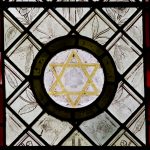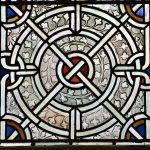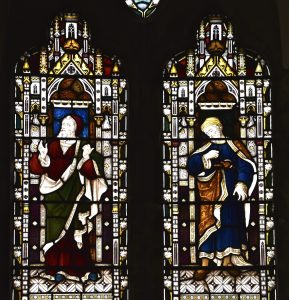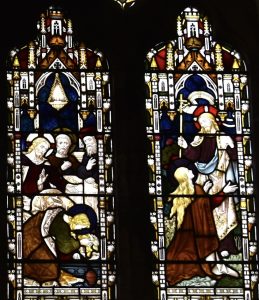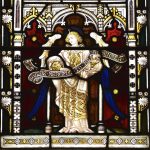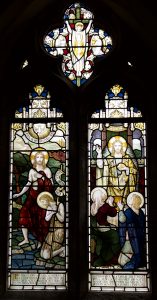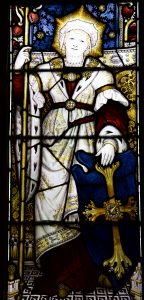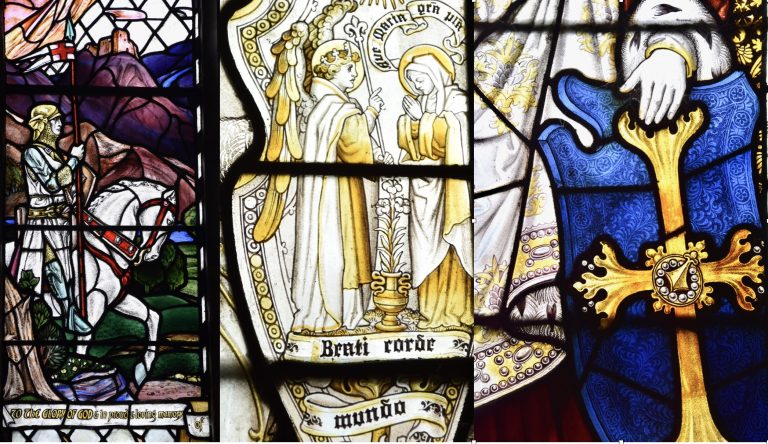 The stained glass windows we see today are mainly the gifts of parishioners, mostly dedicated as memorials following the refurbishment of St Margaret’s which was completed by 1870. These colourful windows replaced the old stained glass which was described as “old, weather beaten quarries”. We do not know if there was any stained glass in the church prior to the Reformation when many church furnishings were lost. (A remnant of our Rood Screen may be seen in the Priest House Museum across the road).
The stained glass windows we see today are mainly the gifts of parishioners, mostly dedicated as memorials following the refurbishment of St Margaret’s which was completed by 1870. These colourful windows replaced the old stained glass which was described as “old, weather beaten quarries”. We do not know if there was any stained glass in the church prior to the Reformation when many church furnishings were lost. (A remnant of our Rood Screen may be seen in the Priest House Museum across the road).
As we enter through the south porch the most modern window is immediately opposite in the north wall.
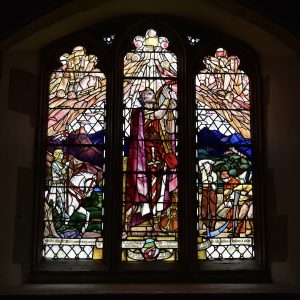 Douglas Strachan was commissioned to create a window in memory of Kenneth Wyndham Arbuthnot who was killed in Belguim in the First World War.
Douglas Strachan was commissioned to create a window in memory of Kenneth Wyndham Arbuthnot who was killed in Belguim in the First World War.
K W Arbuthnot was a retired soldier in the Seaforth Highlanders who reenlisted in 1914. Born at Plawhatch in this parish, he had previously served in Chitral, Sudan and South Africa. His nephew William Archie Arbuthnot Middleton had joined the same regiment as a professional soldier. They were killed together on 25th April 1915 in an early morning attack at Cheddar Villa, near Ypres, which went badly wrong. A third member of the family was also wounded in the same action. His family commissioned Douglas Strachan to create the strikingly coloured stained glass window opposite the church door as a memorial. Strachan wrote that he was inspired by Psalms 24 & 121 among others, with the hills as a symbol of permanence. “That I thought was the Spirit of Hope”. Strachan’s many other commissions include the Scottish National War Memorial in Edinburgh, the Peace Palace in the Hague and, more locally, a series of windows in St Thomas a Becket Winchelsea. He is regarded as one of the foremost stained glass artists of the twentieth century. Arbuthnot’s nephew’s family commissioned Walter Tower (from Lindfield) of Kempe & Company to create the Sir Galahad window on the south wall of the church. Please click on the photo of the window for further visual details.
Turning right towards the altar the next window in the north aisle is The Women at the Sepulchre by Clayton and Bell. It is dedicated to Ann Kirkpatrick (nee Cox) who died in 1874. Ann was married to The Rev. Francis Kirkpatrick who was vicar of West Hoathly from 1850-1872. This monument was erected to her by her sister. The house currently used as the vicarage had not yet been built and the vicar lived in Glebe House, the The Vicarage, to the east of the churchyard. Francis Kirkpatrick was born in Dublin, educated at Trinity College, Dublin and prior to his tenure at West Hoathly had been vicar of St Mary’s Mellor in Lancashire. Sadly this window was not well fired and is much degraded by time. Little detail is left although the figures of Mary Magdalene, Joanna and Mary, mother of James, can be seen in the left light and those of two angels can be distinguished in the right hand light. This episode telling of the first witnesses to the Resurrection is mentioned in all four Gospels but we see that Clayton and Bell have chosen to illustrate the Gospel of Luke, Chapter 24, as each Gospel differs slightly in the details of who was present and this is the only text which mentions three women and two angels.
The East window, over the main altar, is also by Clayton and Bell. Christ in Majesty is at the centre of the image, framed by a mandorla and surrounded by angels including seraphim (six-winged red angels) and cherubim (six-winged blue angels) and a company of saints including St Peter (key), St Catherine of Alexandria (wheel), St Elizabeth of Hungary (flowers), St Agnes (lamb and crown) and St Edward the Confessor (ring). The symbols of the evangelists, Matthew, Mark, Luke and John are under the mandorla in the central panel. It is dedicated to John Blake Kirby of Highbrook who died in 1858. Highbrook Church was not built until 1884.
Clayton and Bell were one of the most prolific glass workshops of the 19th Century. This is relatively early in their output as John Clayton and Alfred Bell only formed their company in in 1855. They worked alongside Heaton and Butler at this time. Their work is to be found in many parish churches (Highbrook has a number of Clayton and Bell windows ) and in higher profile work such as the East window of St George’s Windsor.
To the right of the altar, in the south wall of the Chancel, are two lancet windows by James Powell & Son, latterly known as Whitefriars. The window illustrates John Chapter 15 verse 1 “I am the true vine, and my Father is the husbandman.“
The Hexagon within a circle is repeated four times in the window. The Hexagon can either represent the six attributes of God. (“Six is the number of creation, and perfection, symbolizing divine power, majesty, wisdom, love, mercy, and justice”. George Ferguson, Signs and Symbols in Christian Art, 1954.) or the Star of Creation / Creator’s Star. In this guise it represents the six days in which God created the world, an incomplete work, awaiting perfection. Interestingly the most common shape for pulpits is also hexagonal. The border of intertwined leaves and grapes reminds us of the Last Supper and the Eucharist. The Circle is a symbol of the perfection of God (without beginning or end). Within the hexagon is a flower which may be a Star of Bethlehem. If so it is a visual reference to the birth of Christ. Five petals on flowers may also be a reference to the five wounds of Christ. Grisaille foliage and flowers decorate the outer window quarry tiles. As well as allowing light to fall upon the altar, grisaille windows with abstract or symbolic design have historically been used as aids to contemplative prayer.
Local oral tradition has it that the South Aisle East window was commissioned after a member of the parish visited the Cathedral of St Maurice, Angers and admired the glass there. We do know from a letter found in the archives that it was “designed and executed by Powell, from an example at Angers supposed to be one of the best geometric windows in existence and chosen because of exactly the same date (1285) as (this part of) the church” (Mrs Esdaille to WH Godfrey 26.10.1945.) James Powell’s brother John Cotton Powell lived at Selsfield in the parish and was a generous benefactor to St. Margaret’s, donating the pulpit and supporting the 1870 restoration as lay rector. There are windows in France at St Serge, Angers, in the choir which are very close in design to the West Hoathly window and this may well have been the inspiration cited.
Geometric grisaille windows have traditionally been used as an aid to contemplative prayer since the twelth and thirteenth centuries. There are many examples across Northern France and England (The Five Sisters window in York) and Powell’s glassmakers had an antique example in their collection during the 19th century which has subsquently been donated to the Stained Glass Museum at Ely.
Numerology, symbolism through numbers, was often used in their design as was the symbolism of colour. The use of numerology was widespread amongst the educated in the late thirteenth and early fourteenth century with Dante’s Divine Comedy being a good example of its application in literature.
(Please nb the following is the subjective view of the author. Differing opinions and constructive crticism will be gratefully received. Discussion would be welcomed.)
The circle is commonly recognised as a sign of eternity.
Our window is grisaille (grey) with the addition of just three colours.
Yellow may represent enlightenment or light, the Light of God.
Red may represent sacrifice, The Passion of Christ.
Blue may represent Heaven (or the Blessed Virgin Mary. Heaven is more likely in this context).
Numerology.
One central window. One represents God, the Divine. (“Hear, O Israel: The Lord our God is one Lord” (Deut 6:4.). This is surrounded by two windows.
Two is the number of witness (two witnesses of Revelation, two thieves at the crucifixion, two tablets of the covenant etc). Note also that the central window is differentiated by a yellow border. So – two bearing witness to the one Light of God?
Three represents the Trinity. This is a three light window (ie a composition of three narrow windows creating one design).
Four. Each panel of the side “witness” windows is divided into four by the straight lines forming an X which run the height of each window. Four is the number of creation and wordly things. On the fourth day God created the universe (four seasons, four cardinal points (N,S,E,W) four Gospels to lead man towards God).
The lines also subdivide the central circle of red into a stylized cross.
The circles in the two side windows also contain twelve segments. There were twelve apostles, and the number twelve appears many times in the Bible, for instance as the Twelve Tribes of Israel, as a symbol of good governance.
Each circle in the central window panels, the section representing God, subidvides into sixteen sections. Sixteen may represent love. There are also sixteen coloured pieces in each of the panels in the side windows, with eight coloured pieces found in the corners of each panel. Eight is associated with baptism and resurrection, both fonts and pulpits are frequently eight sided.
It’s worth commenting that our parish magazine in the 1970’s was “The Window”, using this window as its front cover. An encouragement to bear witness to God’s love and sacrifice in the community?
We move on to a simpler pair of windows!
The plaque beneath these windows reads
“In honour of the perpetual God our Father. This building stands in memory of the loyal, mutual and persistent love which existed between Stephenson Clarke and his wife. Now that their life’s work is almost complete they look up to the windows which were procured and placed in 1891.” (translation with thanks to Johnnie Peel, Stephenson’s great great great grandson.)
Stephenson Clarke and his wife Agnes Marie lived at Brook House in Highbrook. They worshipped at West Hoathly prior to the construction of Highbrook Church and supported both churches financially, donating the land upon which All Saints, Highbrook is built as well as the stone for its construction. Stephenson Clarke died in 1891 and Agnes Marie commissioned this pair of two light windows from Clayton and Bell. She also created a trust to pay for the maintenance of these windows, surplus funds from which are still donated to the John Smith Charity which works in this parish. Each window illustrates text from the New Testament with the accompanying text beneath held by an angel. The left window is the parable of the Pharisee and the Publican (Luke 18:9) “The Pharisee stood and prayed thus with himself, God, I thank thee, that I am not as other men are, extortioners, unjust, adulterers, or even as this publican. I fast twice in the week, I give tithes of all that I possess. And the publican, standing afar off, would not lift up so much as his eyes unto heaven, but smote upon his breast, saying, God be merciful to me a sinner.”
The right hand window shows two episodes from the life of Jesus. In the left window light a woman anoints His feet and then wipes them with her hair. This episode occurs in both the gospels of Luke and John (whilst Matthew and Mark describe His head being anointed). This woman has traditionally been identified in Western Art as Mary Magdalene however there is some theological dispute over her identity. The right window light is Noli Me Tangere (“Don’t touch me”), showing the moment that Mary Magdalene is the first person to recognise the risen Christ outside his tomb the day after the Crucifixion.
The lancet window in the middle of the south wall is a First World War memorial to William Archie Middleton, nephew to Kenneth Wyndham Arbuthnot to whom the Strachan window on the opposite wall is dedicated. He was killed in the same action alongside his uncle – so close by that their details are on the same sheet of the Commonwealth War Graves Commission returns. This window is from the workshop of C E Kempe & Company whilst the company was under the management of Walter
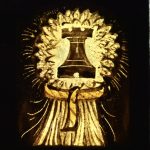 Tower following Kempe’s death in 1907. It is interesting to compare the signature of C E Kempe & Co, which is a rebus of a black tower on a golden garb or sheaf of corn, to the earlier signature of Charles Kempe himself which may be seen in the window of Faith at the west end of this wall. Walter Tower lived in Old Place, Lindfield (which he inherited from his uncle Charles Kempe) and is responsible for the design of the chancel in Highbrook Church. Galahad features in Arthurian legend in his successful quest for the Holy Grail. This window has a small Annunciation scene on Galahad’s shield.
Tower following Kempe’s death in 1907. It is interesting to compare the signature of C E Kempe & Co, which is a rebus of a black tower on a golden garb or sheaf of corn, to the earlier signature of Charles Kempe himself which may be seen in the window of Faith at the west end of this wall. Walter Tower lived in Old Place, Lindfield (which he inherited from his uncle Charles Kempe) and is responsible for the design of the chancel in Highbrook Church. Galahad features in Arthurian legend in his successful quest for the Holy Grail. This window has a small Annunciation scene on Galahad’s shield.
The two light window on the left of the main door is also by James Powell & Son, 1907. It shows scenes from the life of Jesus taken from the Gospel of St Luke. The left light shows John the Baptist kneeling before Christ, hailing him as the Messiah “Ecce Agnus Dei” (Behold the Lamb of God). The Holy Spirit is represented above Christ in the form of a dove (Luke 3:21-22) which tells us that Powell has used Luke as his source because Luke’s is the only description of the Holy Ghost that “descended in a bodily shape like a dove upon him”
In the right light we have moved years forward to after the Resurrection and we see the moment that Cleopas and another disciple (possibly Luke as he chronicles the story in Chapter 24:13 of his gospel) recognised Christ at the wayside inn in “Supper at Emmaus” as he broke bread with them. The breaking of bread has clear references to the Eucharist which Powell draws upon strongly in this image, placing a chalice like vessel on the table and positioning the loaf over Jesus’ heart. The smaller light above shows angels holding a font and a chalice up to a clothed figure of Christ on the cross, surrounded by a border of grapes on a vine in a further Eucharistic reference.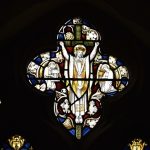 This window was paid for by parishioners of West Hoathly rather than the family of the dedicatees. It is a memorial to Frederick and Margaret Du Croz who served St Margaret’s as church wardens during the latter years of the nineteenth century. Du Croz was a wool merchant and spent much of his life in Van Diemans Land in Australia. Latterly they lived at Courtlands House and he served on the Executive Committee of Lewes and East Grinstead Railway Company during the period when the Railway line (now better known as the Bluebell Railway) was extended south from East Grinstead through our parish to Barcombe. There are further memorials in St Margaret’s to them placed by their family.
This window was paid for by parishioners of West Hoathly rather than the family of the dedicatees. It is a memorial to Frederick and Margaret Du Croz who served St Margaret’s as church wardens during the latter years of the nineteenth century. Du Croz was a wool merchant and spent much of his life in Van Diemans Land in Australia. Latterly they lived at Courtlands House and he served on the Executive Committee of Lewes and East Grinstead Railway Company during the period when the Railway line (now better known as the Bluebell Railway) was extended south from East Grinstead through our parish to Barcombe. There are further memorials in St Margaret’s to them placed by their family.
Faith by Charles Eamer Kempe. Kempe was a leading figure in stained glass design and manufacture during the late 19th Century. His studio produced over 4,000 windows as well as designs for church furnishings. Kempe was born in Ovingdean, Sussex and bought Old Place at Lindfield to renovate in 1875. His work is signed at bottom left with the motif of a golden garb or wheatsheaf which was a device taken from his own coat of arms. This is the earliest of the three windows in the church donated by the Arbuthnot / Middleton family. Helen Arbuthnot Middleton was born in Madras (her father whose memorial 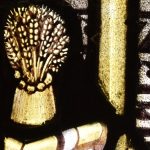 may be seen next to her window was Chairman of the Bank of Madras). Her childhood home was Plawhatch. She died of appendicitis on a ship sailing to South Africa. Helen was the sister of Kenneth W Arbuthnot who is commemorated opposite in the Strachan window and the mother of William Arbuthnot Middleton who is commemorated in the Galahad window.
may be seen next to her window was Chairman of the Bank of Madras). Her childhood home was Plawhatch. She died of appendicitis on a ship sailing to South Africa. Helen was the sister of Kenneth W Arbuthnot who is commemorated opposite in the Strachan window and the mother of William Arbuthnot Middleton who is commemorated in the Galahad window.
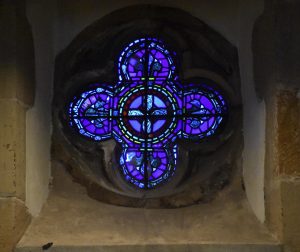
The small window high in the west wall above the font is much beloved by parishioners but little is known about the glass. It appears to be a melange from earlier windows. At the centre is a cross surrounded by three circles which may represent the Holy Trinity. Surrounding the circles are fleur de lis which are stylized flowers with three petals, also representative of the Trinity and in some contexts an attribute of the Blessed Virgin Mary.


